[English] 日本語
 Yorodumi
Yorodumi- PDB-8eia: Crystal structure of beta-catenin and the MDM2 p53-binding domain... -
+ Open data
Open data
- Basic information
Basic information
| Entry | Database: PDB / ID: 8eia | ||||||
|---|---|---|---|---|---|---|---|
| Title | Crystal structure of beta-catenin and the MDM2 p53-binding domain in complex with H333, a Helicon Polypeptide | ||||||
 Components Components |
| ||||||
 Keywords Keywords |  LIGASE / LIGASE /  E3 ligase / E3 ligase /  complex / complex /  stapled peptide stapled peptide | ||||||
| Function / homology |  Function and homology information Function and homology informationCDH11 homotypic and heterotypic interactions / Regulation of CDH19 Expression and Function / positive regulation of heparan sulfate proteoglycan biosynthetic process / lung induction / positive regulation of branching involved in lung morphogenesis / cranial ganglion development / renal vesicle formation / renal inner medulla development / renal outer medulla development / nephron tubule formation ...CDH11 homotypic and heterotypic interactions / Regulation of CDH19 Expression and Function / positive regulation of heparan sulfate proteoglycan biosynthetic process / lung induction / positive regulation of branching involved in lung morphogenesis / cranial ganglion development / renal vesicle formation / renal inner medulla development / renal outer medulla development / nephron tubule formation / mesenchymal stem cell differentiation / beta-catenin-ICAT complex / metanephros morphogenesis / genitalia morphogenesis / embryonic skeletal limb joint morphogenesis / neural plate development / glial cell fate determination / regulation of secondary heart field cardioblast proliferation / astrocyte-dopaminergic neuron signaling / negative regulation of mitotic cell cycle, embryonic / canonical Wnt signaling pathway involved in mesenchymal stem cell differentiation / oviduct development / beta-catenin-TCF7L2 complex / regulation of nephron tubule epithelial cell differentiation / negative regulation of mesenchymal to epithelial transition involved in metanephros morphogenesis / regulation of timing of anagen / Binding of TCF/LEF:CTNNB1 to target gene promoters /  central nervous system vasculogenesis / RUNX3 regulates WNT signaling / regulation of centriole-centriole cohesion / Regulation of CDH11 function / regulation of centromeric sister chromatid cohesion / embryonic axis specification / endodermal cell fate commitment / regulation of fibroblast proliferation / Scrib-APC-beta-catenin complex / positive regulation of fibroblast growth factor receptor signaling pathway / beta-catenin-TCF complex / lens morphogenesis in camera-type eye / dorsal root ganglion development / synaptic vesicle clustering / acinar cell differentiation / dorsal/ventral axis specification / proximal/distal pattern formation / neuron fate determination / layer formation in cerebral cortex / positive regulation of myoblast proliferation / positive regulation of endothelial cell differentiation / sympathetic ganglion development / establishment of blood-retinal barrier / fungiform papilla formation / lung epithelial cell differentiation / embryonic foregut morphogenesis / hindbrain development / regulation of calcium ion import / positive regulation of determination of dorsal identity / positive regulation of skeletal muscle tissue development / ectoderm development / positive regulation of odontoblast differentiation / cellular response to vitamin B1 / response to formaldehyde / cranial skeletal system development / endothelial tube morphogenesis / regulation of protein localization to cell surface / hair cell differentiation / cellular response to indole-3-methanol / mesenchymal cell proliferation involved in lung development / response to water-immersion restraint stress / presynaptic active zone cytoplasmic component / detection of muscle stretch / smooth muscle cell differentiation / central nervous system vasculogenesis / RUNX3 regulates WNT signaling / regulation of centriole-centriole cohesion / Regulation of CDH11 function / regulation of centromeric sister chromatid cohesion / embryonic axis specification / endodermal cell fate commitment / regulation of fibroblast proliferation / Scrib-APC-beta-catenin complex / positive regulation of fibroblast growth factor receptor signaling pathway / beta-catenin-TCF complex / lens morphogenesis in camera-type eye / dorsal root ganglion development / synaptic vesicle clustering / acinar cell differentiation / dorsal/ventral axis specification / proximal/distal pattern formation / neuron fate determination / layer formation in cerebral cortex / positive regulation of myoblast proliferation / positive regulation of endothelial cell differentiation / sympathetic ganglion development / establishment of blood-retinal barrier / fungiform papilla formation / lung epithelial cell differentiation / embryonic foregut morphogenesis / hindbrain development / regulation of calcium ion import / positive regulation of determination of dorsal identity / positive regulation of skeletal muscle tissue development / ectoderm development / positive regulation of odontoblast differentiation / cellular response to vitamin B1 / response to formaldehyde / cranial skeletal system development / endothelial tube morphogenesis / regulation of protein localization to cell surface / hair cell differentiation / cellular response to indole-3-methanol / mesenchymal cell proliferation involved in lung development / response to water-immersion restraint stress / presynaptic active zone cytoplasmic component / detection of muscle stretch / smooth muscle cell differentiation /  histone methyltransferase binding / midbrain dopaminergic neuron differentiation / histone methyltransferase binding / midbrain dopaminergic neuron differentiation /  alpha-catenin binding / alpha-catenin binding /  flotillin complex / traversing start control point of mitotic cell cycle / negative regulation of intrinsic apoptotic signaling pathway by p53 class mediator / Germ layer formation at gastrulation / response to ether / establishment of blood-brain barrier / male genitalia development / negative regulation of oligodendrocyte differentiation / negative regulation of signal transduction by p53 class mediator / flotillin complex / traversing start control point of mitotic cell cycle / negative regulation of intrinsic apoptotic signaling pathway by p53 class mediator / Germ layer formation at gastrulation / response to ether / establishment of blood-brain barrier / male genitalia development / negative regulation of oligodendrocyte differentiation / negative regulation of signal transduction by p53 class mediator /  fascia adherens / epithelial cell proliferation involved in prostate gland development / apicolateral plasma membrane / embryonic brain development / fibroblast activation / Formation of definitive endoderm / atrial septum development / epithelial cell differentiation involved in prostate gland development / positive regulation of epithelial cell proliferation involved in prostate gland development / regulation of smooth muscle cell proliferation / negative regulation of oxidative stress-induced neuron intrinsic apoptotic signaling pathway / oocyte development / beta-catenin destruction complex / lung-associated mesenchyme development / Formation of axial mesoderm / fascia adherens / epithelial cell proliferation involved in prostate gland development / apicolateral plasma membrane / embryonic brain development / fibroblast activation / Formation of definitive endoderm / atrial septum development / epithelial cell differentiation involved in prostate gland development / positive regulation of epithelial cell proliferation involved in prostate gland development / regulation of smooth muscle cell proliferation / negative regulation of oxidative stress-induced neuron intrinsic apoptotic signaling pathway / oocyte development / beta-catenin destruction complex / lung-associated mesenchyme development / Formation of axial mesoderm /  receptor serine/threonine kinase binding / Trafficking of AMPA receptors receptor serine/threonine kinase binding / Trafficking of AMPA receptorsSimilarity search - Function | ||||||
| Biological species |   Homo sapiens (human) Homo sapiens (human)synthetic construct (others) | ||||||
| Method |  X-RAY DIFFRACTION / X-RAY DIFFRACTION /  SYNCHROTRON / SYNCHROTRON /  MOLECULAR REPLACEMENT / Resolution: 3.6 Å MOLECULAR REPLACEMENT / Resolution: 3.6 Å | ||||||
 Authors Authors | Li, K. / Travaline, T.L. / Swiecicki, J.-M. / Tokareva, O.S. / Thomson, T.M. / Verdine, G.L. / McGee, J.H. | ||||||
| Funding support |  United States, 1items United States, 1items
| ||||||
 Citation Citation |  Journal: Nat Commun / Year: 2023 Journal: Nat Commun / Year: 2023Title: Recognition and reprogramming of E3 ubiquitin ligase surfaces by alpha-helical peptides. Authors: Tokareva, O.S. / Li, K. / Travaline, T.L. / Thomson, T.M. / Swiecicki, J.M. / Moussa, M. / Ramirez, J.D. / Litchman, S. / Verdine, G.L. / McGee, J.H. | ||||||
| History |
|
- Structure visualization
Structure visualization
| Structure viewer | Molecule:  Molmil Molmil Jmol/JSmol Jmol/JSmol |
|---|
- Downloads & links
Downloads & links
- Download
Download
| PDBx/mmCIF format |  8eia.cif.gz 8eia.cif.gz | 282.2 KB | Display |  PDBx/mmCIF format PDBx/mmCIF format |
|---|---|---|---|---|
| PDB format |  pdb8eia.ent.gz pdb8eia.ent.gz | 203.5 KB | Display |  PDB format PDB format |
| PDBx/mmJSON format |  8eia.json.gz 8eia.json.gz | Tree view |  PDBx/mmJSON format PDBx/mmJSON format | |
| Others |  Other downloads Other downloads |
-Validation report
| Arichive directory |  https://data.pdbj.org/pub/pdb/validation_reports/ei/8eia https://data.pdbj.org/pub/pdb/validation_reports/ei/8eia ftp://data.pdbj.org/pub/pdb/validation_reports/ei/8eia ftp://data.pdbj.org/pub/pdb/validation_reports/ei/8eia | HTTPS FTP |
|---|
-Related structure data
| Related structure data | 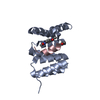 8ehzC  8ei0C 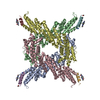 8ei1C  8ei2C  8ei3C  8ei4C 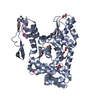 8ei5C 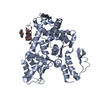 8ei6C 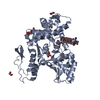 8ei7C 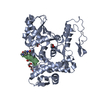 8ei8C 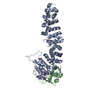 8ei9C  8eibC 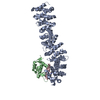 8eicC 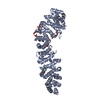 7uwiS S: Starting model for refinement C: citing same article ( |
|---|---|
| Similar structure data | Similarity search - Function & homology  F&H Search F&H Search |
- Links
Links
- Assembly
Assembly
| Deposited unit | 
| ||||||||||||
|---|---|---|---|---|---|---|---|---|---|---|---|---|---|
| 1 |
| ||||||||||||
| Unit cell |
|
- Components
Components
| #1: Protein |  / Beta-catenin / Beta-cateninMass: 58139.312 Da / Num. of mol.: 1 Source method: isolated from a genetically manipulated source Source: (gene. exp.)   Homo sapiens (human) / Gene: CTNNB1, CTNNB, OK/SW-cl.35, PRO2286 / Production host: Homo sapiens (human) / Gene: CTNNB1, CTNNB, OK/SW-cl.35, PRO2286 / Production host:   Escherichia coli (E. coli) / References: UniProt: P35222 Escherichia coli (E. coli) / References: UniProt: P35222 |
|---|---|
| #2: Protein | Mass: 11099.000 Da / Num. of mol.: 1 / Fragment: P53 binding domain Source method: isolated from a genetically manipulated source Source: (gene. exp.)   Homo sapiens (human) / Gene: MDM2 / Production host: Homo sapiens (human) / Gene: MDM2 / Production host:   Escherichia coli (E. coli) Escherichia coli (E. coli)References: UniProt: Q00987, RING-type E3 ubiquitin transferase |
| #3: Protein/peptide | Mass: 2623.918 Da / Num. of mol.: 1 / Source method: obtained synthetically / Source: (synth.) synthetic construct (others) |
| #4: Chemical | ChemComp-WHL / |
| Has ligand of interest | N |
-Experimental details
-Experiment
| Experiment | Method:  X-RAY DIFFRACTION / Number of used crystals: 1 X-RAY DIFFRACTION / Number of used crystals: 1 |
|---|
- Sample preparation
Sample preparation
| Crystal | Density Matthews: 2.45 Å3/Da / Density % sol: 49.79 % |
|---|---|
Crystal grow | Temperature: 291 K / Method: vapor diffusion, sitting drop / pH: 7 Details: 0.1 M Potassium chloride, 0.1 M HEPES pH 7, 15% w/v PEG 5000 MME |
-Data collection
| Diffraction | Mean temperature: 100 K / Serial crystal experiment: N |
|---|---|
| Diffraction source | Source:  SYNCHROTRON / Site: SYNCHROTRON / Site:  NSLS-II NSLS-II  / Beamline: 17-ID-1 / Wavelength: 0.9201 Å / Beamline: 17-ID-1 / Wavelength: 0.9201 Å |
| Detector | Type: DECTRIS EIGER X 9M / Detector: PIXEL / Date: Dec 11, 2021 |
| Radiation | Protocol: SINGLE WAVELENGTH / Monochromatic (M) / Laue (L): M / Scattering type: x-ray |
| Radiation wavelength | Wavelength : 0.9201 Å / Relative weight: 1 : 0.9201 Å / Relative weight: 1 |
| Reflection | Resolution: 3.6→48.03 Å / Num. obs: 7517 / % possible obs: 92.31 % / Redundancy: 5.5 % / Biso Wilson estimate: 86.83 Å2 / CC1/2: 0.978 / Rmerge(I) obs: 0.241 / Net I/σ(I): 5.3 |
| Reflection shell | Resolution: 3.6→3.94 Å / Redundancy: 5.4 % / Rmerge(I) obs: 0.912 / Mean I/σ(I) obs: 1.7 / Num. unique obs: 1803 / CC1/2: 0.491 / % possible all: 94.29 |
- Processing
Processing
| Software |
| |||||||||||||||||||||||||||||||||||||||||||||||||||||||||||||||||||||||||||||
|---|---|---|---|---|---|---|---|---|---|---|---|---|---|---|---|---|---|---|---|---|---|---|---|---|---|---|---|---|---|---|---|---|---|---|---|---|---|---|---|---|---|---|---|---|---|---|---|---|---|---|---|---|---|---|---|---|---|---|---|---|---|---|---|---|---|---|---|---|---|---|---|---|---|---|---|---|---|---|
| Refinement | Method to determine structure : :  MOLECULAR REPLACEMENT MOLECULAR REPLACEMENTStarting model: 7UWI Resolution: 3.6→47.73 Å / SU ML: 0.6739 / Cross valid method: FREE R-VALUE / σ(F): 1.35 / Phase error: 41.6938 Stereochemistry target values: GeoStd + Monomer Library + CDL v1.2
| |||||||||||||||||||||||||||||||||||||||||||||||||||||||||||||||||||||||||||||
| Solvent computation | Shrinkage radii: 0.9 Å / VDW probe radii: 1.1 Å / Solvent model: FLAT BULK SOLVENT MODEL | |||||||||||||||||||||||||||||||||||||||||||||||||||||||||||||||||||||||||||||
| Displacement parameters | Biso mean: 100.55 Å2 | |||||||||||||||||||||||||||||||||||||||||||||||||||||||||||||||||||||||||||||
| Refinement step | Cycle: LAST / Resolution: 3.6→47.73 Å
| |||||||||||||||||||||||||||||||||||||||||||||||||||||||||||||||||||||||||||||
| Refine LS restraints |
| |||||||||||||||||||||||||||||||||||||||||||||||||||||||||||||||||||||||||||||
| LS refinement shell |
| |||||||||||||||||||||||||||||||||||||||||||||||||||||||||||||||||||||||||||||
| Refinement TLS params. | Method: refined / Origin x: 7.74981909216 Å / Origin y: 13.7179774078 Å / Origin z: 20.7883535427 Å
| |||||||||||||||||||||||||||||||||||||||||||||||||||||||||||||||||||||||||||||
| Refinement TLS group | Selection details: all |
 Movie
Movie Controller
Controller


 PDBj
PDBj


























